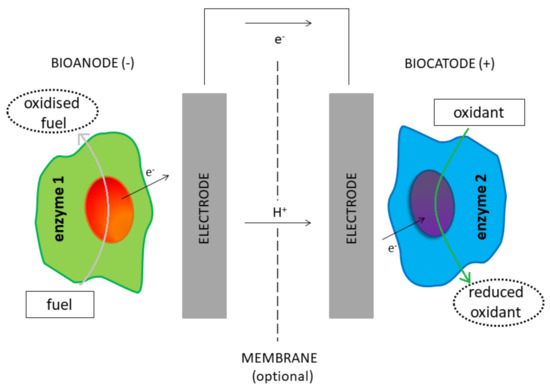Due to the current environmental policies, there is a growing interest in alternative ways to produce green energy with no pollutants and emissions. Among the several developed applications, fuel cells represent a promising technology. In detail, fuel cells transform chemical reactivity into electricity by oxidizing fuel at the anode and reduce oxidant at the cathode, using noble metal catalysts, in order to provide an electrical power output, according to the fuel and oxidant availability [
1]. In this research field, biofuel cells are an interesting application involving biological catalytic reactions at low temperature, in place of metal catalysts, to generate electricity from electrolysis of fuel and oxidant. Hence, a possible classification can be made considering the biological catalyst:
Nowadays EFCs are recognized as renewable and eco-friendly technologies, thanks to their peculiar features as easy miniaturization, portability, potential to produce renewable and sustainable energy [
2]. Moreover, enzymatic biofuel cells present, as benefits, the possibility of operating at room temperature, high conversion efficiency, scalability and great versatility, because they can produce electrical power from a wide range of organic substrates.
Over the last decades, many studies have been carried out on the MFC and EFC development. In particular, as described in [
3], MFCs possessing lifetimes of up to five years have been developed, and many of them can completely oxidize their fuel but have been limited by low current and power densities. On the other hand, EFCs show higher current and power densities, whilst limiting by fuel incomplete oxidation and lower lifetime stability. EFCs, first introduced in 1964 by Yahiro et al. [
4] are expected to be better candidates as biocatalysts than microbes, not only because of their excellent intrinsic properties, such as specificity toward substrate, high catalytic activity with low overvoltage for substrate conversion, and mild operating conditions like ambient temperature and near-neutral pH, but also due to their low cost, renewability and biodegradability. Possible applications range from miniaturized portable electronic equipment, sensors to integrated lab-on-chip power supplies and advanced in vivo diagnostic medical devices that use reactants available in the ambient environment [
5]. The low current density characteristic of EFCs is suitable for a wide variety of self-powered biosensors. Moreover, multiple enzymatic cells can be arranged in series or in parallel configurations, in order to generate enough energy to obtain the desired electrical parameters, thus expanding significantly the possible application areas. EFCs can be also integrated into implantable bioelectronics in living systems. An increasing interest was recently addressed to in vivo tests in many animal species, including mammals. EFCs application in human bodies through minimally invasive devices has also been investigated, reporting examples including contact lenses, which exploit some transparent and flexible materials and use lachrymal fluids, transdermal patches or even tattoos [
2]. Despite all the EFCs advantages described above, research efforts are still directed to overcome the main current issues: long-term stability and high power output. Moreover, although enzymes increase the limited output performance of MFCs related to the mass transfer resistances across the cell membranes [
6], their high selectivity avoids fuel complete oxidation. Several comprehensive reviews on EFCs, focusing on the materials and techniques to enhance electron transfer mechanism and the possible applications relating to wearable and implantable devices have been realized [
1,
2,
6,
7,
8,
9,
10,
11,
12,
13]. Nevertheless, to the best of our knowledge, no review takes into account the performance of flow-based cell designs and the most promising techniques used for electrodes and cell fabrication. Only a mini review exclusively concerning microfluidic EFCs is presented in literature to date [
14]. Therefore, the main aim of this review concerns an in-depth analysis on flow-based configurations for enzymatic biofuel cells, assessing and comparing both microfluidic and non-microfluidic designs in terms of electrochemical performance and stability over the time. Specifically, a great emphasis has been placed on several promising cell fabrication methods and cell power output performance.


